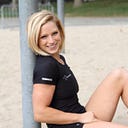The Heavy Lifting: What I Learned About Team-Building From Being A Personal Trainer
I’ve been an athlete for the better part of my life and health and fitness have played major roles in my day-to-day.
I also spent eight years as a personal trainer, creating unique programs for each client to help them achieve their fitness goals. I want to lose weight. I want to be stronger. I’m training to run a marathon. Honestly, I’d like to be able to go up and down my stairs without feeling winded.
With their starting and desired end-points in mind, I’d design an exercise plan to get them from where they were to where they wanted to be.
Throughout my marketing career, I noticed that there were a lot of similarities between exercise planning and team-building. In both cases, you have to identify skills, strengths, and weaknesses. Then, you design a strategy to make the most of these abilities to work towards a goal.
Here are four lessons I’ve learned about building a team, creating a strategy, and learning when to adjust my approach from my time as a personal trainer:
When you’re building a team, you have to be honest about where there are gaps.
At the very beginning of my relationship with a new client at the gym, I’d assess their goals and figure out the best way to get there — realistically.
When growing a team, you have to take the same factors into consideration. In 2014, I took over the marketing department at an architecture firm in New York City. At the time, the marketing team was dedicated primarily to tracking and responding to requests for proposals — setting the team up for only partial success. The question was, How do we increase new business efforts? So we aimed to boost our brand profile and presence to attract new opportunities.
First, I had to evaluate the team I had.
What did each person bring to the table? We each had basic graphic design skills, but one team member outshone the rest. A few excelled as project managers. Some had diverse experience in digital and social media. To meet our goals we needed to cultivate these skills, redistribute the workload, and gear up for new responsibilities. With new objectives in place and a plan for targeted professional development, we were on our way. Finally, we rounded out our group by hiring an excellent copywriter who could tell our story in the most powerful and concise way.
Filling in these skill-gaps helped us get to where we needed to be.
When you’re building a team, do it with purpose.
Take a good, hard look at the people you have, and figure out exactly which skills need to be developed and how to do it.
Be aware of the nuances that make your team unique.
All companies should invest in their employees, and too often, this stops at the hiring process.
As a trainer, I wouldn’t — and couldn’t — stop investing in my clients after completing an initial assessment. If I wanted them to achieve their goals and do my job as a trainer, I’d have to put in just as much work as they did. This meant showing up, leading, teaching, and doing whatever it took to help them get the body they wanted.
If I was really good at it, they’d be motivated to seek out more knowledge on their own.
The same goes for building a team. I can’t hire someone and just think, Hey they’re smart, they’ll figure it out. I have to show up, lead, and teach them so they can ultimately be successful.
People are living and breathing organisms, and we’re all unique. As a trainer, you learn that what works for one body, doesn’t always work for another. Not every client responds the same way to cues, coaching style, or routine. You just have to adjust accordingly.
In an office setting, you have to be just as mindful of what your team members need to do their job well.
Everyone learns differently. Some people find resources, manuals, and seminars most helpful, while others require a more hands-on approach. The same holds true when it comes to management styles — identify what motivators your team best respond to.
In both contexts, you have to tune into and be respectful of what makes each person tick.
Keep the end goal in mind, but be flexible if it changes.
When working with a client in the gym, things don’t always play out exactly how you thought they would.
You can’t control what your client does when they aren’t training with you. Usually, if they weren’t seeing the results they wanted, it was because they were falling short somewhere else — failing to make it to the gym on days they don’t see you or not sticking to their diet. I couldn’t slap pizza out of their hands or do their grocery shopping. But I could look at how they were progressing and change my approach.
It’s similar when managing a team. If an employee or your team is consistently not meeting objectives, take a look at why. Have I set them up with the tools they need to succeed? Are they being managed properly? Is the problem motivation based?
When you’re coaching or looking to foster growth in someone, you have to pay attention to what’s working and what’s not.
And what happens if it’s the goal that’s changed? You have to cater to shifting priorities. Start by reevaluating your team’s strengths and weaknesses and how they measure up in the new dynamic. It’s all about harnessing team member strengths and adapting — which might mean adjusting your training and employee development to fill a new skill gap.
The point is to be flexible, realistic, and in some cases, you just have to make do with what you’ve got.
Know your own limitations as a leader.
As a trainer, it’s pretty discouraging if your client isn’t getting the results they want.
But you have to know your limitations. I often advised on healthy diet choices, but I’m not a nutritionist and should not write detailed diet plans. When a client had an injury, I’d suggest they consult their doctor before proceeding.
Sometimes, it’s best to defer to someone who knows better.
And as a marketing team leader, I come up against the same type of limitations. Maybe I notice that a campaign or initiative didn’t perform well. Why? At a previous marketing job, for example, whenever engagement on our email campaigns was low, I’d loop in our art director, communications manager, and product expert to test different messaging and visual elements. In the end, we would identify what impacted engagement and implement them moving forward for more successful campaigns.
Don’t be afraid to admit you don’t know everything and be proactive about seeking a solution. Consult an analyst, a superior, a mentor, or bring in a team member who’s particularly skilled in the specific area to help devise a plan.
In the end, your business is on the line.
On the surface, building a team and creating an exercise plan seem like they couldn’t be more different. But they’re both about analyzing the finer points about what makes people unique, being realistic and proactive about your goals, and being flexible enough to change your approach when you need to.
If you can accomplish all of those things, you’ll have a fantastic team that can handle whatever comes their way — or a very happy client.
This piece was originally published in Minutes.

